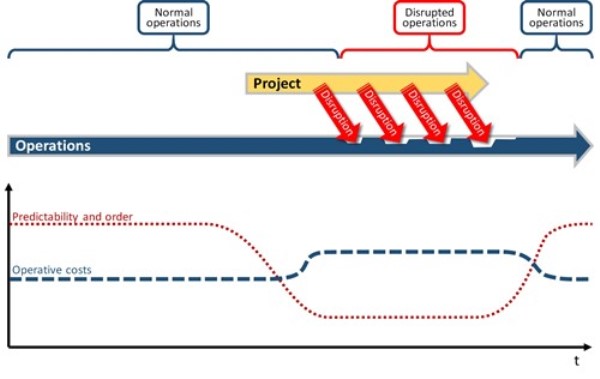Project Business Management
SERIES ARTICLE
By Oliver F. Lehmann
Munich, Germany
Summary
While project management must generally deal with conflicts among stakeholders, managing disputes gets particularly important when a project is done by more than one organization. Project Business Management experts have some tools that can help effectively resolving such conflicts. There is a need to develop more.
Conflicts in Project Business
Why does it Matter?
Project Business Management describes how organizations such as companies, agencies, and other institutions perform projects jointly in a customer-contractor relationship.
It is a measurable trend[1]: More projects are partially or fully outsourced and outtasked to vendors of products and services, based on the expectation that the external contractor is in a better position to do the work and deliver results as expected. However, this decision adds areas of conflict that are often poorly understood, and that should be addressed in a specific way to protect the success of the project.
The number of organizations involved may be just two, a customer and a contractor. Often, contractors hire subcontractors, who in turn may pass work on to sub-subcontractors, and so on. The number of companies (and individuals under contract, such as freelancers) involved may then become quite big.
This is a similar development that operations had in the recent decades, when they developed supply chain management (SCM) with its specific skills and software. However, the temporary nature of projects and hence the business relationships between the organizations makes it much more difficult to manage its Project Supply Networks (PSNs), while they are growing by number and complexity, and cope with their dynamics and opacity.
Causes of Conflicts in Project Management
Internal projects inside organizations are commonly done in a cross-functional style, also referred to as “Matrix”, and have various sources of conflict, among them:
- Competition for human and physical resources between operations and project(s)
- Operational disruptions caused by project(s)
- Control over success-critical decision processes, such as staffing and procurement
- “Servant of two masters” dilemmas for employees assigned as team members
- Uncertainties for the performing organization from the level of risk that is inherent in projects
- Competition for management attention, the scarcest resource in most organizations
The second item “operational disruptions” is often overlooked. It is among the hidden costs of projects in matrix organizations, when they impact operations, often even at times when the project has been finished long ago.

Figure 1: Disruptions and uncertainties from a project can reduce the effectiveness and efficiency of operations
More…
To read entire article, click here
Editor’s note: This series of articles is by Oliver Lehmann, author of the book “Project Business Management” (ISBN 9781138197503), published by Auerbach / Taylor & Francis in 2018. See author profile below.
How to cite this article: Lehmann, O. (2019). Title; Series on Project Business Management; PM World Journal, Vol. VIII, Issue IV (May). Available online at https://pmworldlibrary.net/wp-content/uploads/2019/05/pmwj81-May2019-Lehmann-Healing-Conflicts-in-Project-Business2.pdf
About the Author

Oliver F. Lehmann
Munich, Germany
![]()
Oliver F. Lehmann, MSc., PMP, is a project management author, consultant, speaker and teacher. He studied Linguistics, Literature and History at the University of Stuttgart and Project Management at the University of Liverpool, UK, where he holds a Master of Science Degree. Oliver has trained thousands of project managers in Europe, USA and Asia in methodological project management with a focus on certification preparation. In addition, he is a visiting lecturer at the Technical University of Munich.
He has been a member and volunteer at PMI, the Project Management Institute, since 1998, and served five years as the President of the PMI Southern Germany Chapter until April 2018. Between 2004 and 2006, he contributed to PMI’s PM Network magazine, for which he provided a monthly editorial on page 1 called “Launch”, analyzing troubled projects around the world.
Oliver believes in three driving forces for personal improvement in project management: formal learning, experience and observations. He resides in Munich, Bavaria, Germany and can be contacted at oliver@oliverlehmann.com.
Oliver Lehmann is the author of “Situational Project Management: The Dynamics of Success and Failure” (ISBN 9781498722612), published by Auerbach / Taylor & Francis in 2016 and of “Project Business Management” (ISBN 9781138197503), published by Auerbach / Taylor & Francis in 2018.
To view other works by Oliver Lehmann, visit his author showcase in the PM World Library at https://pmworldlibrary.net/authors/oliver-f-lehmann/
[1] The trend is confirmed in surveys on customer side, where “Make-or-Buy” decisions tend to select more often the “Buy” option than “Make”, and on contractor side, as a growing percentage of project managers say that they do projects for paying customers (Lehmann, 2018a, pp. 8-10).









